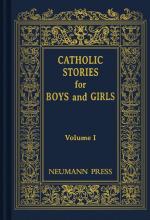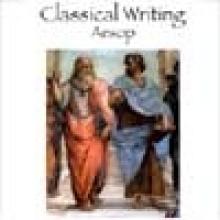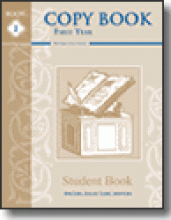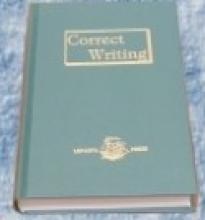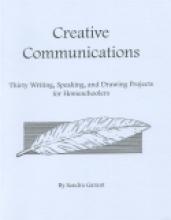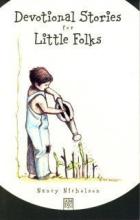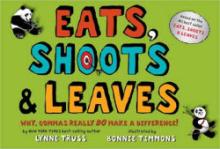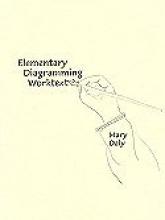Language Arts
Catholic Stories for Boys and Girls
These charming readers, which are appropriate for a second grade reading level, contain "stories written and compiled in days long past by Catholic nuns in America and dedicated to Mary the Mother of God our dear Lady of the Miraculous Medal." My second grader (who is somewhat advanced in reading level) enjoyed these very much and polished off all four volumes in the first week of school - including one book which she read straight through without putting it down (she requested that I include that detail in the review). She really loves the small size and the beauty of the books themselves and has read them over and over.
I thought it was nice how the stories were so often inter-related as many of them were about the Sisters of Charity and some of their pupils, the founder St. Vincent de Paul, and other related saints, including St. Catherine Laboure and St. Elizabeth Ann Seton. The books introduced my daughter to these saints and others (including St. Isaac Jogues and St. Edmund Campion) and she is now planning on working her way through the Vision Books and Mary Fabyan Windeatt titles about these saints.
The books would offer some good reading practice, a little more appealing than the older Catholic reading texts, while promoting Catholic virtues and tidbits from history. The numerous illustrations are black and white silhouette-like drawings.
Because the books were written for younger children many decades ago, they do display a slight amount of "twaddle" in a few places, along the lines of "'Tick, tock, tick, tock,' said the schoolroom clock as it looked down on the children reading and writing. It liked the French country children." Fortunately, most of the stories are not written in this style. Some parents don't like the way that souls are described as "black" or "white" instead of "in the state of sin" or "in the state of grace" because of the confusing connotations with regard to ethnic background (this also comes up in the Treasure Box Books). Also, although I don't think the authors intended it to come across this way, there is one story in the fourth book which appears to condone one boy beating up another for calling his brother a thief and for cursing. If I remember right, all of these possible objections are limited to the same story in the fourth book ("The Flowery Kingdom" starting on page 45).
4 volumes, 140 pages each
Classical Writing: Aesop
If you are attracted to the classical method of teaching composition, by analyzing and imitating excellent literature, but have struggled with implementing your own program, then this is the writing series for you. Meticulously thought through and well organized, Classical Writing: Aesop combines structure with flexibility. It can be used with multiple ages in the homeschool and, though designed for beginning writers in grades 1-5, can be adapted for older ages. It uses homeschool-friendly methods such as copywork, dictation, literary discussion and narration, as building blocks for composition skills.
Classical Writing: Aesop is the first in a proposed series which will cover the various steps of the progymnasata (literally "preliminary exercises") by which classical and medieval students were taught to write in a variety of different modes. Classical Writing: Aesop covers the first exercise in the progymnasata, narration of fables. The child learns to retell simple fables and tales in his own words, adding dialogue and description in easy increments over the course of the curriculum. This is the "imitation" component.
The analysis component of the course, in which the literature selection is carefully gone over at several different levels, can be adjusted to the level of the student(s). A week's routine is divided into (1) introducing and discussing the model (2) word skills (3) sentence skills (4) copywork or easy dictation. A beginner would practice basic phonics and learn about how to tell a sentence. A more advanced student would practice beginning dictionary skills and learn the parts of speech. Though a supplemental grammar book is recommended, Classical Writing contains teaching tips and content for all the formal grammar that is needed at this level.
There are plenty of charts to help with the organization of the course. Appendices include some sample fables and tales to use as models, and even a sample 36-week syllabus for busy moms who want to pick up the book and go rather than write their own lesson plans (though a sample lesson plan template is included, too). There is even a description of how the authors, both homeschooling mothers of four, use the program with their own children, with examples of narrative exercises by their children of various ages.
This is not intended to be a self-teaching curriculum. It is meant for the homeschooling parent to use *with* children. It is suggested that half an hour per day be spent on each of the components of the course, analysis and imitation, four days a week. The authors believe that composition is a formative skill, and should be guided: "training in speech and writing cannot be separated from training in virtue". The goal is a "habit of mind" which the students can apply to any writing task. This is a thoroughly Catholic idea – that "academic" skills should be at the service of virtue– that I have not found so well stated and carried through in any other writing curriculum. I am looking forward to using this program with my grade school children, and have already adapted elements of it for use with my older children.
The book is available in a Kinko's copy, or in a PDF file that can be downloaded from the internet. The PDF file is probably the most versatile, since multiple copies of the sample models can be printed out for use with more than one child. See below for the Classical Writing website, which also has a link to a message board for support of this product.
The authors also offer Traditional Tales - Models for Classical Writing, a sourcebook of 36 fables and traditional tales to use with the composition course. The models include fairytales, Scripture, history stories by James Baldwin, in addition to fables by Aesop: all excellent literature which can be read by the fluent primary age child. This book is not an essential companion to Classical Writing, since the sources are all in the public domain and can be found online (some URLs are listed in the handbook). Still, it is a savings of time and effort for the homeschool mom to have them selected and right at one's fingertips. Downloadable PDF format and Kinko's copy format both available from Classical Writing.
Copybook: First Year
Memoria Press' new copybooks provide a brilliantly simple combination of handwriting practice and memory work (simple Bible verses and classic poems from authors such as Robert Louis Stevenson). The child first practices simple letters before getting into Bible passages and poetry. These lessons also include space for illustrating the verse (great for reading comprehension!). Bible passages are taken from the King James Version of the Bible. Though the King James Bible does not suffice for Catholic religious instruction, it is rightly valued for its literary qualities and contributions to the English language. The Bible passages selected, which include passages important to Catholics like "I am the Bread of Life," are completely unobjectionable.
Correct Writing
This 525 page hardcover is Book 1 in the once popular Catholic high school series "A Course For Secondary Schools." Fortunately, for those who want to continue educating their children along the lines of Voyages in English series, Lepanto press has reprinted this 1952 gem.
Correct Writing is a detailed treatment of grammar using anecdotes, occasional book excerpts and other narratives. Rather then study grammar using isolated sentences, users of this book are exposed to longer narratives that are of interest to teenagers. These narratives are often humorous and more often then not contain Catholic content. Studying grammar within a larger framework allows the older student to learn correct grammar and writing easily and almost painlessly.
Topics covered include sentence structure, subject, predicate, nouns, verbs, appositives, moods, prepositional phrases, gerunds, participles, infinitives, adjectives, adverbs, and ruls for capitalization and punctuation. Each part of speech is clearly introduced (often accompanied by an anecdote that shows good humor) along with isolated examples and occasional cartoons. Several exercises are provided including both oral and written drills to reinforce the concept learned. This book includes traditional diagramming and exercises that have the student rewrite sentences or complete narratives correcting mistakes in punctuation or grammar. Separate proof-reading programs such as Editor in Chief are unnecessary when using this book. Creative writing assignments are also built into each chapter requiring the student to apply the concepts that they have learned in the text.
This textbook could be used in 8th grade or as soon as a child has completed Voyages 7 or other comparable program. The writing style and content of the exercises is best suited for age 13 years and up. Our 14 year old son enjoyed using this program and looked forward to doing it each day.
The answer key is highly recommended since some of the later exercises are challenging.
Creative Communications
This is a book of projects to encourage communication - and especially writing - in practical (and often fun) ways that are especially appropriate for homeschool families. The book is divided into three sections...
The first section "Pre-Writing Projects" includes seven projects to encourage those just beginning-to-write-a-little to be well-prepared for writing by playing word and memory games, writing name tags, learning manners relating to meeting and talking to people, labeling household items, telling stories, singing songs, writing lists, etc. Far from being a list of projects, this twenty-five page section includes quite a bit of detail, adequate descriptions and many ideas for implementation of these projects. You'll also find examples of particular people working on their communication skills and ideas for gaining the cooperation of reluctant writers. I found these descriptions quite creative and it is obvious that the author has really used these ideas in her own family.
Section Two covers ten "Short Projects for Ready Writers" which includes projects such as composing prayers, having a pen pal or a "cyber-pal" to write to, writing menus, making greeting cards, taking telephone messages (and other aspects of telephone communication and etiquette), special story-writing ideas and a family newsletter project. One of the appendices also includes a listing of websites where children can find Catholic pen pals on the Internet. This section also includes tips for parents on "When Is Your Child Ready to Write?", "Communication is Worth the Work" and "Ready for Informal Grammar". I think the ideas are very practical and very homeschool-mom friendly.
Thirteen "Advanced Projects for Real Writers" are covered in Section Three. These include projects of a more advanced nature which "require spelling and grammar skills, but ... also require planning, thought, and some technical skills." These are designed for those old enough to do a good deal of independent work with parental approval but minimum parental supervision/assistance. Projects range from learning to express spiritual beliefs and convictions to writing tests and study guides, from practicing proofreading skills to simple computer programming and audio/video productions. (To give you a better sense of this section, the following is a list of the project titles: "Wearable Words", "Study Guides", "Writing Your Own Tests", "Journals with a Theme", "Magazine and Newsletter Submissions", "Proofreading Skills", "Instructional Aids", "Memory Book", "Family History", "Calendars", "Action Letters", "Computer Programs" and "Radio and Video Production".)
In addition, you'll find: extensive tips and explanations on the whys and hows of teaching writing - including helping children to be motivated to write and a short essay encouraging teens to use communication skills to do good within the community and gain valuable experience. Appendices include twenty four "plot situations" to get started on writing assignments, a listing of "How to" Books and Websites relating to the projects; suggested supplies, an overview of copyright laws and Fair Use Policies, simple grammar rules and sixteen pages of writing samples from the author's children (which help to illustrate some of the project ideas given in the text.
Most of the content is very practical (and family-oriented) in nature. Religious content extends to ideas and examples (within the various projects) that would be of interest to Catholic homeschoolers, such as writing letters to television stations to encourage moral programming and helping spread devotion to the Sacred Heart. I find the author quite creative in using ordinary experiences as good learning opportunities. I'm looking forward to digging into some of the projects with my own children this fall.
The author is a Catholic mother of three, a free-lance writer, and has been homeschooling her children since 1989.
Cursive Connections: A Traditional Style
The text is strictly black and white with no distracting illustrations. (These details are a matter of personal preference - I prefer this simpler style and others would rather have more colorful texts.) This text would be easy to use in a homeschooling situation because of the introductory information is rather complete: "the purpose of these materials", "who uses these materials", "practice methods", "expectations of the child", "correct paper position", etc. Different sorts of cursive strokes are explained as well as several examples of poorly done letters alongside "better" and "best" examples.
Individual cursive letters are given quite a bit of practice space on their own, and then practiced alongside other individual letters (particularly those which are more difficult to connect). As more and more letters are introduced, the practice begins to include short words and some phrases. After all of the lower-case cursive letters are introduced, the text moves along to Upper Case. "When should a capital letter connect to the next letter?" and when it should be left alone is also clearly explained.
This is in no way a "religious" text. However, the words God, and many Christian names (such as Xavier) are included in the word practice pages. Also, there is absolutely no offensive or "politically correct" content.
Devotional Stories for Little Folks
Nancy Nicholson (author of numerous titles from Catholic Heritage Curricula including the My Catholic Speller and Language of God for Little Folks series) hits another homerun with this new title. Thirty-six stories centering around family life offer humor, entertainment and gentle lessons in morality. The stories are perfect for reading aloud during breakfast or lunch. Each story includes related quotes from the Bible or the Catechism of the Catholic Church, vocabulary words and questions for discussion. My children have taken great delight in listening to and "figuring out" these charming stories.
Eats, Shoots and Leaves
Elementary Diagramming Worktext
This is simple, clearly presented, and in a pleasing font; examples are profuse, and exercises numerous. It includes a complete answer key, on different colored paper, in the back of the book. Ours was just a shrink-wrapped set of 3-hole-punched pages which we put into a simple binder. No fancy bindings, but an excellent presentation. The eight chapters include The Sentence: Subject and Verb, Three Articles, Adjectives, Direct Objects, Linking Verbs, Adverbs, Prepositions, and A Peek Ahead. The introductory paragraph sums up the book succinctly: "Usually, we teach diagramming very gradually and even spread it over several years because there are so many details to learn. The trouble is, diagramming is a sort of language, though only a written language, and until you can use it for everyday thinking, you can't get used to it...Perhaps grammar could be taught a lot earlier and faster if it were made simple and visual." That is what the author has done...simply and visually.
Update:The second edition (2002) contains 71 pages plus a 38 page answer key. The binding is now a "perfect bound" softcover binding. The content is essentially the same.
Copyright 1998 / 2002

